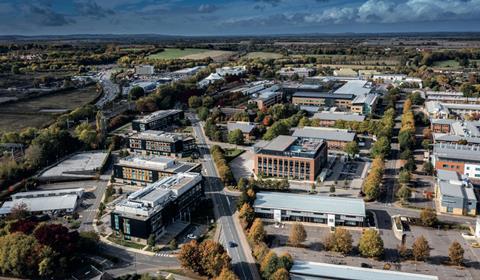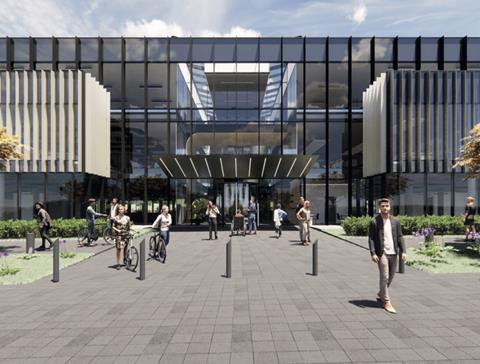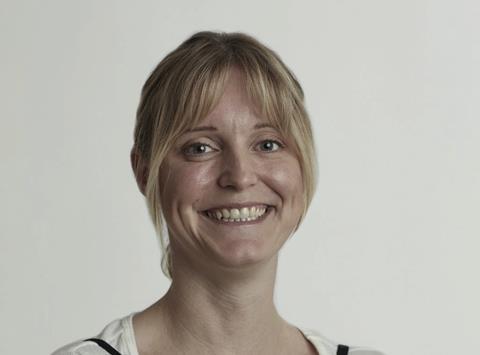The market is being led by the ‘golden triangle’ – and potentially emerging regions within the country. Christopher Walker reports
It has been a “turbulent time” in the UK life-sciences real estate market recently, according to Emma Goodford, head of life sciences at Knight Frank. “In 2022, a lot of investors realised the opportunities in this sector and deployed funds. Some developers entered at very high price points, as the supply situation remains incredibly tight.
“Fortunately, as they proceeded, they have come to realise the need for a considered and measured approach. There has also been a realisation in the market of the important role specialists can play. There are clear successful specialists emerging, such as Oxford Properties, Kadans and Pioneer Group.”
John O’Driscoll, global co-head of real estate at AXA IM Alts, agrees with both these points. “Pre the current market cycle, there was a short period where it was getting a little heated, with high prices being paid for assets to gain exposure and/or in anticipation of tenant demand driving rents to an unrealistic level,” he says.
“Over the last 18 months, we have seen more rational competition around assets and balanced underwriting assumptions, with a greater overall focus on delivery and the value that a specialist in the sector, like Kadans, brings.” AXA IM Alts acquired specialist life-sciences developer and operator Kadans in 2020.

Milton Park, a science and technology park in Oxfordshire owned by Federated Hermes, is indicative of the growth being driven in the UK life-sciences market
The UK life-science sector continues to grow, with recent data from the UK government’s Office for Life Sciences recording a 5% yearly increase in employment, while £2.6bn (€3bn) of venture capital (VC) was deployed into UK life-sciences companies in 2023, surpassing the pre-pandemic average by 37%.
Chris Walters, head of UK life sciences at JLL, notes: “These two indicators alone are complimented by a high growth in start-up activity, anchored by world-leading academic and research institutions.”
The UK also has a much lower base of supply of life-science real estate compared with the larger, more established US market. It also has a significantly slower response of development pipeline. Historic cities, a complex planning environment and tight land ownership have resulted in new space coming forward more gradually.
Artem Korolev, founder and CEO of specialist developer Mission Street, says: “We believe that the actual development pipeline, even in places like Oxford and Cambridge, will be delayed and constrained versus previous expectations. This will result in undersupply persisting in the long term, keeping down vacancy and driving rental growth.”
The investment case for UK life-science real estate looks solid, but O’Driscoll thinks it is “probably getting stronger”. He lists several factors: “The UK is a leading force globally in education and R&D and cultivation of life-science industry remains very high up the national agenda. It is a strong market for talent and remains of global appeal.
“The increasing convergence of science with technology, notably artificial intelligence, is also an important positive for the UK, which has a strong existing technology sector including the presence of many leading global players.”
The UK government’s role in all this is certainly crucial and encouraged by the fact the sector employs more than 280,000 people and contributes £94bn to the UK economy every year.
In February 2023, the government established the Department of Science Innovation and Technology and published its Life Sci for Growth strategy – a 10-point plan with ambitions to make the UK a ‘science superpower’ by 2030. Included in this was a £650m package to support the life-sciences sector. Further, the government has accepted, and plans to implement, all the recommendations from the Oxford University-led spin-out review which proposed recommendations to help improve the creation and growth of university spin-out companies.

“Critical infrastructure in the UK is slowing and, in some cases, preventing laboratory developments coming forward to market”
ARIEL LEVY
Goodford says: “The UK government continues to have a strong focus on encouraging the development of the life-sciences sector and this is unlikely to change with any change of government.”
There have also been considerable successes in the past 12 months. The UK agreed to rejoin the EU’s Horizon research programme, which it left following Brexit, ending an episode of uncertainty over funding for UK research. An agreement on VPAG, the new system on medicine subsidies, was also reached between the government and the National Health Service (NHS).
“Many in the pharmaceutical industry have been concerned at what level these subsidies would be set, given the pressures on healthcare spending, but the end result is expected to be one that continues to support research and development,” notes Goodford.
“Over the last year, both public and private investment has accelerated, while technology and data, AI and other emerging fields of science are driving further growth in the market,” says Philip Campbell, commercial director at MEPC – the specialist developer owned by Federated Hermes with responsibility for managing and developing Milton Park, a science and technology park in Oxfordshire.
“We are in a golden age for life sciences; in the post-pandemic economy, UK and international investor interest in life-sciences real estate continues to grow, with the demand-supply imbalance of available lab and manufacturing space supporting continued rental growth.”
But Mike Wiseman, head of workspace leasing, innovation and life sciences at UK-listed real estate investment trust British Land has some words of caution. “Significant barriers to growth must be overcome, including an overburdened planning regime, increasing international competition for funding and stringent NHS price cap on medicine sales, alongside a more challenging tax environment. We believe that to deliver growth, the government must act now.”
Likewise, Ariel Levy, co-founder of Gen Two Real Estate, cautions: “Critical infrastructure in the UK is slowing and, in some cases, preventing laboratory developments coming forward to market. Access to power is holding the industry back from building both the labs we need, and ensuring they are ESG-compliant.”
The golden triangle
UK life-science real estate attracted about £5.8bn in investment between 2021 and 2023. Within this period, £4.5bn of that total (78%), was invested specifically in the ‘golden triangle’ of Oxford, Cambridge and London, which dominate life sciences in the UK.
Walters says: “What is clear is that the advanced clusters in the golden triangle…. are experiencing robust levels of demand, low vacancy rates, a lack of near-term high-quality lab stock and rental growth.”

“Advanced clusters in the golden triangle… are experiencing robust levels of demand”
CHRIS WALTERS
According to JLL, at the end of 2023, 2.3m sqft of lab space was being sought by life-science companies in the golden triangle, of which 45% was focused on the Cambridge market. Vacancy rates across the golden triangle remain low at 1-4%, with limited new stock coming to the market in the near term. This robust demand story against a shortage of dedicated and high-quality supply has fuelled significant year-on-year rental growth of 9-15% in prime, fully fitted labs across the golden triangle.
Rental growth in Cambridge has been over 30% in the past year and fitted labs are now being leased at £70 per sqft. “These are big numbers,” says Goodford. “Oxford is not quite reaching those levels. Rents are more around £60 a sqft, but in both of the university cities the situation remains positive, with demand outstripping supply.”
Wiseman fears that this lack of supply means the golden triangle “falls short when compared to the flourishing US market”. He explains: “According to our recent research, the US has more stock in more places, with Oxford – home to the fourth-best-ranked university for life sciences in the world – home to less laboratory space than Denver, which has no university in the top 100.”
The US can also deliver space more quickly than the UK, with construction under way to increase the supply of lab space by 5.2% a year in Oxford and Cambridge compared with 8.9% a year in Boston.
British Land is delivering 1.9m sqft of lab-enabled buildings in the UK over the next seven years, including the Peterhouse Technology Park in Cambridge and a 170,000sqft development at the Botley Road Retail Park site in Oxford. While at Milton Park, between Didcot and Abingdon in Oxfordshire, Federated Hermes has created the largest single-ownership life-sciences cluster in the UK with over 3m sqft of floor space, including 800,000sqft of laboratory space, over 300 acres.
But it could be that constraints in the ancient university cities mean that London will soon take the lead. Increasingly, Wiseman feels, “London is at the heart of this”. Although the London market is more nascent than that of Oxford and Cambridge, “its access to capital and research via its proximity to top universities, healthcare providers, medical charities and innovative start-ups, alongside its status as a global city, means that it is uniquely positioned to unlock exciting growth opportunities”, Wiseman says.
“London is already the capital of innovation for Europe,” he adds, citing the city’s position as a global leader in AI and the fact that it is home to more unicorns – start-ups that have grown to be worth more than US$1bn – than anywhere else in Europe. “A big reason for this is its culture of innovation and growth, and it will be this ecosystem that accelerates life sciences in the years ahead.”

British Land is delivering the Peterhouse Technology Park in Cambridge
Important in this regard is the way in which developments are increasingly mixed-use, with offices featuring alongside labs. At its Regent’s Place campus, British Land is delivering 700,000sqft of lab and office space. The company has also recently submitted plans for the transformation of the nearby Euston Tower office building, which will be redeveloped into a mixed-use building with a focus on science and innovation.
And at Canada Water, a 52-acre masterplan has the potential to be another significant innovation cluster, with the design of 300,000sqft of new high-quality space to support science and innovation businesses.
Walters says London “is the dominant cluster in the UK” with over 1,400 companies, employing 46,000 people, “over 40% of post-pandemic VC, four top-20 academic institutions for life sciences and the strongest start-up concentration”.
In other regional hubs, speculative development of specialised lab space has been more modest. However, Goodford is clear that “it is likely there will be growth in the UK market as the life-sciences sector concentrates more on manufacturing applications and contract research-driven demand”.
This is very much borne out by the work of Bruntwood SciTech and its partnership with LGIM and Greater Manchester Pension Fund (see Q&A on page 40), but also by John Leake, business growth director at Sci-Tech Daresbury, located in the Liverpool City region, and chair of the UK Science Park Association. “There is predicted very significant growth in the North of England, the Northern Health Sciences Alliance has reported, with employment expected to double from 2020 to 2040 and GVA [gross value added] tripling from just over £5bn to over £16bn.”
New technologies are key in this outward spread. An R&D facility at Sci-Tech Daresbury for PsiQuantum, a recently opened US-based quantum computing company, has received US$700m of investment to date. According to Leake, the facility “will play a key part in their innovation pathway to developing the first usable quantum computer tapping into the expertise and cryogenic facilities in STFC’s Daresbury Laboratory”.

“The line between what constitutes a life-sciences company and what constitutes a technology company will become increasingly blurred”
EMILY SLUPEK
Emily Slupek, partner at Bidwells, highlights an “interesting development” – a convergence of the technology and life-sciences sectors. “Financial pressures on drug discovery, the increased availability of data and technological advancements mean that the line between what constitutes a life-sciences company and what constitutes a technology company will become increasingly blurred,” she says.
From a physical real estate perspective, this shift might entail the construction of science and technology buildings that can accommodate both needs within one ecosystem, with a blend of office and computing space with wet laboratory facilities.
“Where it is not possible for science and technology providers to be situated within the same ecosystem, it is important that the right infrastructure is in place to facilitate face-to-face collaboration,” say Slupek. “This means further capital expenditure into things like transport and housing.”
Bidwells surveyed science and tech companies and found that two-thirds wanted their partners located within two hours’ travel. “This is because face-to-face collaboration is important,” says Slupek.
US life-science real estate: Signs of ageing or pause for breath?

After a period of boom, the world’s most developed life-science real estate market has slowed. Christopher Walker checks the vitals of the sector
- 1
 Currently
reading
Currently
reading
The UK life-science real estate market evolves fast
- 3
- 4
- 5
- 6
- 7
- 8


































